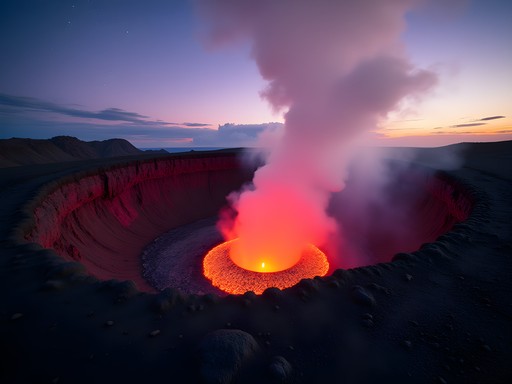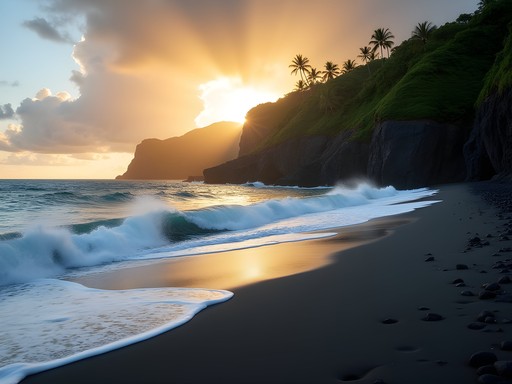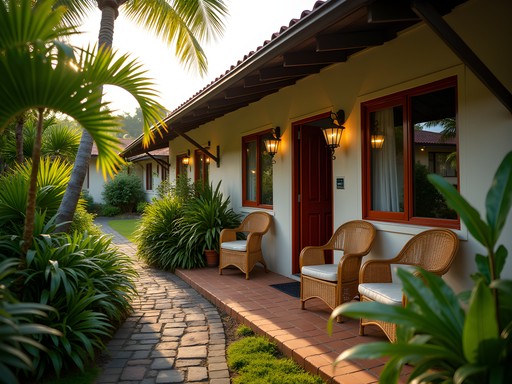Disclosure: This article contains affiliate links. We may earn a commission from purchases at no extra cost to you, which helps our travel content.
Having observed celestial phenomena across six continents, I find myself continually drawn back to Hawaii Island's eastern shores. Hilo presents a rare convergence of astronomical and geological marvels that speaks to both my scientific curiosity and adventurous spirit. The island's active volcanism offers couples a unique opportunity to witness Earth's primordial forces firsthand—a reminder that our planet remains very much alive and in constant flux, much like the dynamic celestial bodies I've studied throughout my career.
Volcanoes National Park: Where Earth Reveals Its Inner Workings
Hawaii Volcanoes National Park serves as the crown jewel of any Hilo adventure. As someone who has studied the heavens professionally, I find equal wonder in exploring Earth's geological processes. The park encompasses two active volcanoes—Kilauea and Mauna Loa—offering accessible glimpses into planetary formation that typically requires powerful telescopes to observe elsewhere in our solar system.
During my most recent visit, I spent three days exploring the Chain of Craters Road, which winds 19 miles from the summit of Kilauea down to the sea. The landscape transforms dramatically along this route, from lush rainforest to barren lava fields where previous flows have consumed everything in their path. For night hiking near steam vents or lava viewing, I rely on my headlamp, which offers both standard and red-light modes—the latter preserving night vision for stargazing afterward.
The Jaggar Museum area, though the building itself remains closed after 2018's eruption, provides the safest and most spectacular vantage point for observing Halema'uma'u crater. I recommend bringing a portable chair for comfortable extended viewing—you'll want to stay for hours as daylight fades and the crater's glow intensifies against the darkening sky.

💡 Pro Tips
- Visit the Kilauea Visitor Center first for current eruption updates and safety information
- Plan crater viewing for sunset to witness both daylight features and nighttime incandescence
- Bring layers—temperatures at the summit can drop significantly after dark
Lava Tube Exploration: Journey Through Ancient Volcanic Arteries
While the celestial bodies I've studied throughout my career remain distant, Hawaii's lava tubes offer the rare opportunity to literally step inside volcanic processes. Thurston Lava Tube (Nāhuku) within the national park provides an accessible introduction, but for couples seeking more adventurous exploration, I recommend venturing to the less-visited Kaumana Caves just outside Hilo.
During my exploration of Kaumana, I was struck by the parallels between these subterranean passages and the celestial tunnels formed by solar magnetic fields that I once studied. Both represent energy pathways of enormous magnitude, though operating at vastly different timescales. The caves extend for miles, though only the first quarter-mile is easily accessible without specialized equipment.
For such explorations, proper footwear is essential. I've found my hiking boots provide the necessary traction on slippery surfaces while protecting against the sharp volcanic rock. Equally important is a reliable flashlight with extended battery life—the darkness within these tubes is absolute, and cellular signals don't penetrate the dense volcanic rock overhead.

💡 Pro Tips
- Wear gloves to protect hands when scrambling over rough lava surfaces
- Bring backup lighting sources—darkness is absolute if your primary light fails
- Never explore beyond the developed sections without proper caving equipment and experienced guides
Mauna Kea Summit: Where Astronomy Meets Adventure
No visit to Hilo would be complete without experiencing Mauna Kea, the dormant volcano that rises 13,803 feet above sea level. As an astronomer who has conducted research at observatories worldwide, I find this mountain particularly special—not only for its world-class astronomical facilities but also for the cultural significance it holds for Native Hawaiians as a connection point between earth and sky.
The summit's high altitude, combined with minimal light pollution and stable air conditions, creates one of Earth's premier stargazing locations. While the professional observatories aren't generally open to the public, the Visitor Information Station at 9,200 feet hosts regular stargazing programs. Here, you can observe celestial objects through provided telescopes while knowledgeable staff explain both the scientific and cultural significance of the night sky.
The journey to Mauna Kea's summit requires preparation. Altitude sickness is a genuine concern, so I always recommend spending at least 30 minutes acclimating at the Visitor Information Station before proceeding higher. For the summit's often frigid conditions, I pack my down jacket which provides exceptional warmth while compressing small enough to fit in my daypack when not needed.
For couples interested in photography, the summit offers unparalleled opportunities for astrophotography. I've captured some of my most treasured images here using a sturdy travel tripod to stabilize long exposures in the often windy conditions.

💡 Pro Tips
- Acclimate at the Visitor Information Station for at least 30 minutes before continuing to the summit
- Visit for sunset, then return to the Visitor Station for stargazing—the combination provides the complete experience
- Four-wheel drive vehicles are required for summit access; book a tour if your rental car doesn't qualify
Wailuku River State Park: Volcanic Forces Meet Tropical Waters
While Hilo's volcanic features rightfully command attention, the interaction between these ancient lava flows and more recent water systems creates equally fascinating landscapes. Wailuku River State Park, just minutes from downtown Hilo, showcases this dynamic through two remarkable features: Rainbow Falls (Waiānuenue) and Boiling Pots (Pe'epe'e Falls).
Rainbow Falls derives its name from the frequent morning rainbows that appear in its mist when the sun hits at just the right angle. As someone accustomed to analyzing light spectra professionally, I find particular delight in these natural prisms. The waterfall plunges 80 feet over an ancient lava cave that, according to Hawaiian mythology, houses Hina, the goddess of the moon—a celestial connection I find particularly meaningful.
Upstream, Boiling Pots presents a series of large pools connected by cascading rapids. These depressions formed when rapidly cooling lava created bubbles and depressions that were later filled by the river. During heavy rains, water churns through these formations, creating the boiling appearance that gives the area its name.
For exploring these areas, particularly after rain when rocks become slippery, I recommend trekking poles for additional stability. When photographing around waterfalls, I protect my electronics with a waterproof phone case that allows touchscreen use while providing complete protection against both water and volcanic grit.

💡 Pro Tips
- Visit Rainbow Falls in the morning hours (around 9-10am) for the best chance of seeing the namesake rainbows
- Never swim in Boiling Pots or the pools above Rainbow Falls—underwater currents are extremely dangerous
- The short trails around both attractions become very slippery after rain; appropriate footwear is essential
Night Lava Viewing: Earth's Cosmic Light Show
When Kilauea is actively erupting, few experiences rival witnessing molten lava against the night sky. As someone who has spent decades studying celestial light sources, I find Earth's own luminous display equally mesmerizing. The current eruption activity varies, so checking with the National Park Service before planning your visit is essential.
During active periods, several viewing opportunities exist. The most accessible is from designated viewing areas within Hawaii Volcanoes National Park. For more adventurous couples, guided hikes to closer viewing locations are available when conditions permit. These typically depart in late afternoon, arriving at optimal viewing locations as darkness falls.
My most profound experiences have come during these nighttime excursions, where the boundary between astronomy and geology seems to dissolve. The incandescent glow of molten rock—reaching temperatures of approximately 2,000°F—illuminates gas plumes from within, creating ethereal formations against the star-filled Hawaiian night.
For these excursions, I rely on my thermal insulated water bottle to keep hydration readily available without condensation issues in the humid environment. I also recommend a cooling towel for managing heat from both volcanic sources and hiking exertion.

💡 Pro Tips
- Check the Hawaii Volcanoes National Park website or call the visitor center for current eruption status before planning your visit
- Book guided lava viewing tours well in advance during active eruption periods
- Bring red-filtered lighting to preserve night vision while navigating dark trails
Final Thoughts
After decades studying celestial phenomena across the globe, I find Hilo's volcanic landscape offers a uniquely accessible window into planetary processes usually reserved for distant worlds. The island presents couples with a rare opportunity to witness Earth's creative and destructive forces simultaneously—where new land emerges even as existing formations erode and transform. This dynamic between permanence and impermanence mirrors what I've observed in star formations throughout my astronomical career.
As you plan your own volcanic adventures around Hilo, remember that these landscapes demand both respect and preparation. The very features that make this region extraordinary also present genuine hazards to unprepared visitors. Yet with proper planning and equipment, couples can safely experience these primordial forces together, creating shared memories of standing at the boundary between Earth's molten heart and the infinite cosmos above.
I encourage you to approach Hilo's volcanic wonders with both scientific curiosity and cultural reverence. The Hawaiian people have developed sophisticated understanding of these landscapes over centuries, interweaving geological knowledge with cultural practices that honor the profound connection between land, sea, and sky. In doing so, you'll discover that volcanoes offer not just thrilling adventures, but deeper insights into our planet's place in the cosmic order.
✨ Key Takeaways
- Hilo offers accessible volcanic experiences found nowhere else on Earth, from lava tubes to active eruptions
- Proper preparation with appropriate gear ensures both safety and comfort in diverse volcanic environments
- The combination of geological and astronomical features creates unique opportunities for understanding cosmic processes
- Respecting both natural hazards and cultural significance enhances the experience of these powerful landscapes
📋 Practical Information
Best Time to Visit
Year-round, though December-March has higher rainfall. Eruption activity varies unpredictably.
Budget Estimate
$1,500-2,500 per couple for one week including accommodations, car rental, activities, and meals
Recommended Duration
5-7 days minimum to experience major volcanic features without rushing
Difficulty Level
Moderate - Requires Reasonable Fitness For Hiking On Uneven Terrain With Some Elevation Changes
















Comments
adventurelegend
Great post! How difficult is the lava tube exploration for someone with mild claustrophobia? Would you recommend it anyway for the experience?
Scarlett Cox
Thanks for asking! The main section of Thurston Lava Tube is actually quite spacious with good lighting. If you're concerned, I'd suggest visiting early morning when there are fewer people. The extended section (requiring flashlights) might be more challenging for claustrophobia, but the main tube is definitely manageable!
adventurelegend
That's really helpful, thanks! I'll stick to the main section and see how I feel. Definitely don't want to miss experiencing this while in Hilo!
journeydiver
Going to Hilo next month! How difficult is the lava tube exploration? Safe for kids?
Mason Sullivan
The main Thurston Lava Tube is totally kid-friendly! Well-lit path, paved walkway. My nephew (8) loved it. There are more challenging ones if you want adventure, but start with Thurston!
journeydiver
Perfect, thanks Mason! That's exactly what I needed to know.
Mason Sullivan
Scarlett, your post took me right back to my trip to Hilo last year! I'm still dreaming about that sunrise hike across the volcanic landscape - felt like walking on another planet. For anyone planning to visit Mauna Kea, I'd recommend acclimating at the visitor center for at least 30 minutes before heading to the summit. The altitude hit me harder than expected despite being in decent shape. Also, don't make my mistake - bring layers! I was freezing at the top with just my light jacket. The contrast between tropical beaches in the morning and near-freezing temps at night was wild. Used my compact binoculars for stargazing and they were perfect for the conditions up there. The Wailuku River was another highlight - those rainbow falls are even more impressive in person than photos suggest!
wanderlife
Just got back from Hilo last month and the Volcanoes National Park blew my mind! We saw actual lava flowing at night which was surreal. The ranger told us we were super lucky with the timing. Those lava tubes you mentioned were incredible too - felt like walking through the veins of the earth. Did anyone else feel a bit claustrophobic in the narrower sections though? Worth pushing through the anxiety for sure. Planning to go back next year to catch the stargazing on Mauna Kea that we missed!
journeydiver
The tubes freaked me out too but totally worth it! Did you do the summit tour or just the visitor center at Mauna Kea?
wanderlife
We only made it to the visitor center because our rental car wasn't allowed to go up to the summit. Next time we're booking a proper tour!
oceanrider
Just got back from Hilo last week and your post is spot on! The Mauna Kea stargazing was life-changing - I've never seen the Milky Way so clearly. Pro tip for anyone heading there: acclimate at the visitor center for at least 30 minutes before continuing to the summit. And pack layers! I was freezing even with my down jacket in August. The volcanic landscapes around Kilauea were otherworldly, especially at dusk when the crater glow becomes visible. Don't miss the Jaggar Museum overlook if it's reopened when you visit!
greenmate
How many nights would you recommend staying in Hilo to see everything?
oceanrider
We did 4 nights and it felt just right. 2 days for volcano stuff, 1 day for Mauna Kea, and 1 day for waterfalls/town exploring.
islandhopper
Going to be in Hilo next month! Is it worth spending two full days at Volcanoes National Park or should I use one day for Wailuku River area?
Bryce Diaz
Not Scarlett, but I'd recommend one full day at Volcanoes NP and half a day at Wailuku. Rainbow Falls is stunning but doesn't require a full day. Use your extra time to check out the Pana'ewa Rainforest Zoo if you're into wildlife - it's free and has some species you won't see elsewhere!
islandhopper
Thanks for the tip! Didn't even know about the zoo.
wanderstar2530
How difficult are the lava tube hikes? Planning to visit with my parents (65+) who are reasonably fit but I'm worried about accessibility.
Scarlett Cox
The main Thurston Lava Tube (Nāhuku) is actually quite accessible with a paved path and lighting. It's about a 20-minute walk round trip. There are some steps, but many seniors do it without issue. For more challenging tubes, I'd recommend a guided tour where guides can help navigate trickier sections.
wanderstar2530
That's perfect! Thanks so much for the info. Will definitely stick to Thurston with them.
Frank Garcia
Brilliant write-up on Hilo's volcanic wonders, Scarlett! I backpacked through the area last year and was absolutely mesmerized by the geological diversity. The contrast between the molten activity at Kilauea and the stargazing potential atop Mauna Kea creates this perfect scientific playground. For anyone planning a visit, I'd recommend allocating at least 3 days to properly explore Volcanoes National Park - the Chain of Craters Road deserves its own day entirely. The rangers there provide exceptional context that transforms the experience from mere sightseeing to genuine education about planetary processes.
oceanrider
Did you need a 4WD to access Mauna Kea summit? I've heard mixed things about the road conditions.
Frank Garcia
Yes, you definitely need 4WD for the summit road. I joined a tour instead - they handle the driving and provide warm gear (it gets COLD up there). The visitor center at 9,000ft is accessible with any vehicle though, and still offers decent stargazing.
greenmate
Those lava tubes look incredible! Definitely adding this to my bucket list.
travelbug55
Those night sky photos from Mauna Kea are incredible! Adding this to my bucket list.
Venture X
Premium card with 2X miles, $300 travel credit, Priority Pass